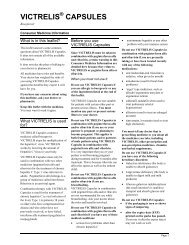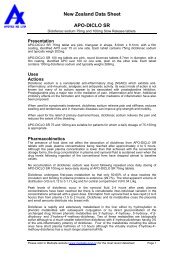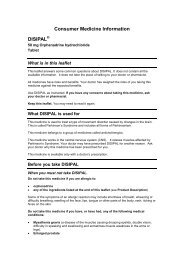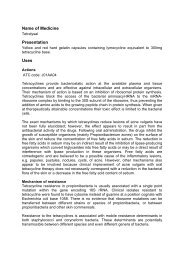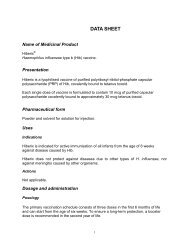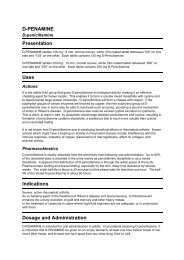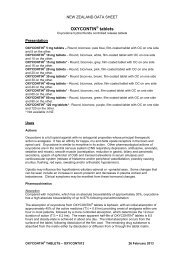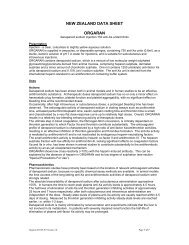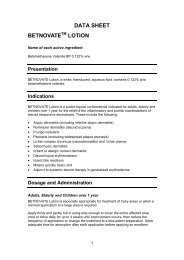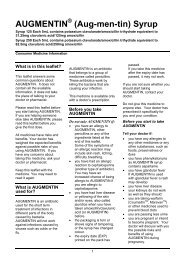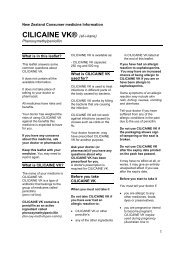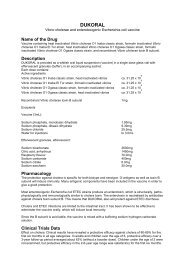NEW ZEALAND DATA SHEET SYNTOCINON - Medsafe
NEW ZEALAND DATA SHEET SYNTOCINON - Medsafe
NEW ZEALAND DATA SHEET SYNTOCINON - Medsafe
Create successful ePaper yourself
Turn your PDF publications into a flip-book with our unique Google optimized e-Paper software.
PRESENTATION(S)<br />
<strong>NEW</strong> <strong>ZEALAND</strong> <strong>DATA</strong> <strong>SHEET</strong><br />
<strong>SYNTOCINON</strong> ®<br />
Synthetic Oxytocin<br />
5 IU/mL and 10 IU/mL<br />
Concentrate for solution for infusion; Solution for injection<br />
Active substance: synthetic oxytocin.<br />
Pharmaceutical form: Concentrate for solution for infusion; Solution for injection containing<br />
5 IU/mL or 10 IU/mL. One ampoule contains 1 mL solution.<br />
Excipients: Sodium acetate trihydrate, acetic acid glacial, chlorobutanol, ethanol 94% w/w,<br />
water for injections.<br />
INDICATIONS<br />
Antepartum:<br />
• Induction of labour for medical reasons, e.g. in cases of post-term gestation, premature<br />
rupture of the membranes, pregnancy-induced hypertension (pre-eclampsia).<br />
• Enhancement of labour in selected cases of uterine inertia.<br />
• Syntocinon ® may also be indicated in early stage of pregnancy, as adjunctive therapy for<br />
management of incomplete, inevitable or missed abortion.<br />
Postpartum:<br />
• During caesarean section, but after the delivery of the child.<br />
• Prevention and treatment of postpartum uterine atony and haemorrhage.<br />
DOSAGE AND ADMINISTRATION<br />
Induction or enhancement of labour<br />
Syntocinon should be administered as an intravenous (i.v.) drip infusion or, preferably, by<br />
means of a variable-speed infusion pump. For drip infusion it is recommended that 5 IU of<br />
Syntocinon be added to 500 mL of a physiological electrolyte solution (such as sodium chloride<br />
0.9%). For patients in whom infusion of sodium chloride must be avoided, 5% dextrose solution<br />
may be used as the diluent (see Warnings and precautions). To ensure even mixing, the bottle<br />
or bag must be turned upside down several times before use.<br />
1
The initial infusion rate should be set at 1 to 4 milliunits/minute (2 to 8 drops/minute). It may be<br />
increased gradually at intervals not shorter than 20 minutes and increments of not more than 1<br />
to 2 milliunits/minute until a contraction pattern similar to that of normal labour is established. In<br />
pregnancy near term, this can often be achieved with an infusion of less than 10 milliunits/<br />
minute (20 drops/minute), and the recommended maximum rate is 20 milliunits/minute (40<br />
drops/minute). In the unusual event of higher rates being required, as may occur in the<br />
management of foetal death in utero or for induction of labour at an earlier stage of pregnancy<br />
when the uterus is less sensitive to oxytocin, it is advisable to use a more concentrated<br />
Syntocinon solution, e.g. 10 IU in 500 mL.<br />
When using a motor-driven infusion pump which delivers smaller volumes than those given by<br />
drip infusion, the concentration suitable for infusion within the recommended dosage range<br />
must be calculated according to the specifications of the pump.<br />
The frequency, strength and duration of contractions and also the foetal heart rate must be<br />
carefully monitored throughout the infusion. Once an adequate level of uterine activity is<br />
attained, the infusion rate can often be reduced. In the event of uterine hyperactivity and/or<br />
foetal distress, the infusion must be discontinued immediately.<br />
If, in women who are at term or near term, regular contractions are not established after the<br />
infusion of a total amount of 5 IU, it is recommended that the attempt to induce labour should be<br />
terminated; it may be repeated on the following day, starting again from a rate of 1 to<br />
4 milliunits/minute.<br />
Incomplete, inevitable, or missed abortion<br />
5 IU by i.v. infusion (5 IU diluted in physiological electrolyte solution and administered as an i.v.<br />
drip infusion or, preferably, by means of a variable-speed infusion pump over 5 minutes) or 5 to<br />
10 IU i.m., if necessary followed by i.v. infusion at a rate of 20 to 40 milliunits/minute.<br />
Caesarean section<br />
5 IU by i.v. infusion (5 IU diluted in physiological electrolyte solution and administered as an i.v.<br />
drip infusion or, preferably, by means of a variable-speed infusion pump over 5 minutes)<br />
immediately after delivery.<br />
Prevention of postpartum uterine haemorrhage<br />
The usual dose is 5 IU by i.v. infusion (5 IU diluted in physiological electrolyte solution and<br />
administered as an i.v. drip infusion or, preferably, by means of a variable-speed infusion pump<br />
over 5 minutes) or 5 to 10 IU i.m. after delivery of the placenta.<br />
2
In women given Syntocinon for induction or enhancement of labour, the infusion should be<br />
continued at an increased rate during the third stage of labour and for the next few hours<br />
thereafter.<br />
Treatment of postpartum uterine haemorrhage<br />
5 IU by i.v. infusion (5 IU diluted in physiological electrolyte solution and administered as an i.v.<br />
drip infusion or, preferably, by means of a variable-speed infusion pump over 5 minutes), or 5 to<br />
10 IU i.m., followed in severe cases by intravenous infusion of a solution containing 5 to 20 IU of<br />
oxytocin in 500 mL of an electrolyte-containing diluent, run at the rate necessary to control<br />
uterine atony.<br />
CONTRAINDICATIONS<br />
• Known hypersensitivity to oxytocin or to any of the excipients of Syntocinon.<br />
• Hypertonic uterine contractions, foetal distress when delivery is not imminent.<br />
• Any condition in which, for foetal or maternal reasons, spontaneous labour is unadvisable<br />
and/or vaginal delivery is contraindicated: e.g. significant cephalopelvic disproportion, foetal<br />
malpresentation; placenta praevia and vasa praevia, placental abruption, cord presentation<br />
or prolapse; overdistension or impaired resistance of the uterus to rupture as in multiple<br />
pregnancy, polyhydramnios, grand multiparity and in the presence of a uterine scar resulting<br />
from major surgery including classical caesarean section.<br />
Syntocinon must not be administered within 6 hours after vaginal prostaglandins have been<br />
given.<br />
WARNINGS AND PRECAUTIONS<br />
Induction of labour:<br />
The induction of labour by means of oxytocin should be attempted only when strictly indicated<br />
for medical reasons rather than for convenience. Administration should only be under hospital<br />
conditions and qualified medical supervision.<br />
Syntocinon should not be used for prolonged periods in patients with oxytocin-resistant uterine<br />
inertia, severe pre-eclamptic toxaemia or severe cardiovascular disorders.<br />
Syntocinon should not be given as i.v. bolus injection as it may cause an acute short-lasting<br />
hypotension accompanied with flushing and reflex tachycardia.<br />
Cardiovascular disorders:<br />
Syntocinon should be used with caution in patients who have a pre-disposition to myocardial<br />
ischemia due to pre-existing cardiovascular disease (such as hypertrophic cardiomyopathy,<br />
3
valvular heart disease and/or ischemic heart disease including coronary artery vasospasm), to<br />
avoid significant changes in blood pressure and heart rate in these patients.<br />
QT syndrome:<br />
Syntocinon should be given with caution to patients with known ‘long QT syndrome’ or related<br />
symptoms and to patients taking drugs that are known to prolong the QTc interval (see<br />
Interactions).<br />
When Syntocinon is given for induction and enhancement of labour:<br />
• It must only be administered as an i.v. infusion, and never by s.c., i.m. or i.v. bolus injection.<br />
• Foetal distress and foetal death: Administration of oxytocin at excessive doses results in<br />
uterine overstimulation which may cause foetal distress, asphyxia and death, or may lead to<br />
hypertonicity, tetanic contractions or rupture of the uterus. Careful monitoring of foetal heart<br />
rate and uterine motility (frequency, strength, and duration of contractions) is essential, so<br />
that the dosage may be adjusted to individual response.<br />
• Particular caution is required in the presence of borderline cephalopelvic disproportion,<br />
secondary uterine inertia, mild or moderate degrees of pregnancy-induced hypertension or<br />
cardiac disease and in patients above 35 years of age or with a history of lower-uterinesegment<br />
caesarean section.<br />
• Disseminated intravascular coagulation: In rare circumstances, the pharmacological<br />
induction of labour using uterotonic agents including oxytocin increases the risk of post<br />
partum disseminated intravascular coagulation (DIC). The pharmacological induction itself<br />
and not a particular agent is linked to such risk. This risk is increased in particular if the<br />
woman has additional risk factors for DIC such as being 35 years of age or over,<br />
complications during the pregnancy and gestational age more than 40 weeks. In these<br />
women, oxytocin or any other alternative drug should be used with care, and the practitioner<br />
should be alerted by signs of DIC.<br />
Intrauterine death:<br />
In the case of foetal death in utero, and/or in the presence of meconium-stained amniotic fluid,<br />
tumultuous labour must be avoided, as it may cause amniotic fluid embolism.<br />
Water intoxication:<br />
Because oxytocin possesses slight antidiuretic activity, its prolonged i.v. administration at high<br />
doses in conjunction with large volumes of fluid, as may be the case in the treatment of<br />
inevitable or missed abortion, or in the management of postpartum haemorrhage, may cause<br />
water intoxication associated with hyponatraemia. The combined antidiuretic effect of oxytocin<br />
and the i.v. fluid administration may cause fluid overload leading to a hemodynamic form of<br />
acute pulmonary oedema without hyponatraemia. To avoid these rare complications, the<br />
following precautions must be observed whenever high doses of oxytocin are administered over<br />
4
a long time: an electrolyte-containing diluent must be used (not dextrose); the volume of infused<br />
fluid should be kept low (by infusing oxytocin at a higher concentration than recommended for<br />
the induction or enhancement of labour at term); fluid intake by mouth must be restricted; a fluid<br />
balance chart should be kept and serum electrolytes should be measured when electrolyte<br />
imbalance is suspected.<br />
Caution should be exercised in patients with severe renal impairment because of possible water<br />
retention and possible accumulation of oxytocin (see Further Information).<br />
Women of child-bearing potential, pregnancy, breast-feeding and fertility<br />
Use in Pregnancy:<br />
Pre-clinical data for oxytocin reveal no special hazard based on conventional studies of single<br />
dose acute toxicity, genotoxicity and mutagenicity. No standard teratogenicity and reproductive<br />
performance studies with oxytocin are available (see Warnings and precautions: Other). Based<br />
on the wide experience with this drug and its chemical structure and pharmacological<br />
properties, it is not expected to present a risk of foetal abnormalities when used as indicated.<br />
Use in Lactation:<br />
Oxytocin may be found in small quantities in mother’s breast milk. However, oxytocin is not<br />
expected to cause harmful effects in the newborn because it passes into the alimentary tract<br />
where it undergoes rapid inactivation.<br />
Effects on ability to drive and use machines<br />
Syntocinon can induce labour, therefore caution should be exercised when driving or operating<br />
machines. Women with uterine contractions should not drive or use machines.<br />
Special Populations<br />
Renal impairment:<br />
No studies have been performed in renally impaired patients.<br />
Hepatic impairment:<br />
No studies have been performed in hepatically impaired patients.<br />
Paediatric patients:<br />
No studies have been performed in paediatric patients.<br />
Geriatric patients:<br />
No studies have been performed in elderly patients (65 years old and over).<br />
Other: Non-clinical safety data<br />
5
Pre-clinical data for oxytocin reveal no special hazard for humans based on conventional<br />
studies of single dose acute toxicity, genotoxicity, and mutagenicity.<br />
Mutagenicity:<br />
An in vitro genotoxicity and mutagenicity study with oxytocin has been reported. Tests were<br />
negative for chromosomal aberration and sister chromatid exchange in human peripheral<br />
lymphocyte cultures. No significant changes in the mitotic index were noticed. Oxytocin had no<br />
genotoxic properties. The genotoxic potential of oxytocin has not been determined in vivo.<br />
Carcinogenicity, teratogenicity and reproduction toxicity:<br />
Treatment of rats with oxytocin in early pregnancy at doses considered sufficiently in excess of<br />
the maximum recommended human dose caused embryonic loss in one study. No standard<br />
teratogenicity, reproductive performance and carcinogenicity studies with oxytocin are<br />
available.<br />
ADVERSE EFFECTS<br />
When oxytocin is used by i.v. infusion for the induction or enhancement of labour, its<br />
administration at excessive doses results in uterine overstimulation which may cause foetal<br />
distress, asphyxia and death, or may lead to hypertonicity, tetanic contractions or rupture of the<br />
uterus.<br />
Rapid i.v. bolus injection of oxytocin at doses amounting to several IU may result in acute shortlasting<br />
hypotension accompanied with flushing and reflex tachycardia (see Warnings and<br />
precautions). These rapid haemodynamic changes may result in myocardial ischaemia,<br />
particularly in patients with pre-existing cardiovascular disease. Rapid i.v. bolus injection of<br />
oxytocin at doses amounting to several IU may also lead to QTc prolongation.<br />
In rare circumstances (i.e. incidence rate
Adverse reactions (Table 1 and 2) are ranked under heading of frequency, the most frequent<br />
first, using the following convention: very common (≥ 1/10); common (≥ 1/100, < 1/10);<br />
uncommon (≥ 1/1,000, < 1/100); rare (≥ 1/10,000, < 1/1,000) very rare (< 1/10,000), including<br />
isolated reports. The adverse drug reactions tabulated below are based on clinical trial results<br />
as well as post-marketing reports.<br />
The adverse drug reactions derived from post-marketing experience with Syntocinon are via<br />
spontaneous case reports and literature cases. Because these reactions are reported<br />
voluntarily from a population of uncertain size, it is not possible to reliably estimate their<br />
frequency which is therefore categorised as unknown. Adverse drug reactions are listed<br />
according to system organ classes in MedDRA. Within each system organ class, adverse drug<br />
reactions are presented in order of decreasing seriousness.<br />
Table 1: Adverse drug reactions in mother<br />
Immune system disorders<br />
Rare: Anaphylactoid reaction associated with dyspnoea, hypotension or shock<br />
Nervous system disorders<br />
Common: Headache<br />
Cardiac disorders<br />
Common: Tachycardia, bradycardia<br />
Uncommon: Arrhythmia<br />
Not known: Myocardial ischaemia, QTc prolongation<br />
Vascular disorders<br />
Not known: Hypotension<br />
Gastrointestinal disorders<br />
Common: Nausea, vomiting<br />
Skin and subcutaneous tissue disorders<br />
Rare: Rash<br />
Pregnancy, puerperium and perinatal conditions<br />
Not known: Uterine hypertonicity, tetanic contractions, rupture of the uterus<br />
Metabolism and nutrition disorders<br />
Not known: Water intoxication, maternal hyponatraemia<br />
Respiratory, thoracic and mediastinal disorders<br />
Not known: Acute pulmonary oedema<br />
General disorders and administrative site conditions<br />
Not known: Flushing<br />
Blood and lymphatic system disorders<br />
Not known: Disseminated intravascular coagulation<br />
Table 2: Adverse drug reactions in foetus/neonate<br />
Pregnancy, puerperium and perinatal conditions<br />
Not known: Foetal distress, asphyxia and death<br />
Metabolism and nutrition disorders<br />
Not known: Neonatal hyponatraemia<br />
7
INTERACTIONS<br />
Interactions resulting in a concomitant use not recommended<br />
Prostaglandins and their analogues:<br />
Prostaglandins and their analogues facilitate contraction of the myometrium hence oxytocin can<br />
potentiate the uterine action of prostaglandins and analogues and vice versa (see<br />
Contraindications).<br />
Drugs prolonging the QT interval:<br />
Oxytocin should be considered as potentially arrhythmogenic, particularly in patients with other<br />
risk factors for torsades de pointes such as drugs which prolong the QT interval or in patients<br />
with history of long QT syndrome (see Warnings and precautions).<br />
Interactions to be considered<br />
Inhalation anaesthetics:<br />
Inhalation anaesthetics (e.g. cyclopropane, halothane, sevoflurane, desflurane) have a relaxing<br />
effect on the uterus and produce a notable inhibition of uterine tone and thereby, may diminish<br />
the uteronic effect of oxytocin.<br />
Vasoconstrictors/sympathomimetrics:<br />
Oxytocin may enhance the vasopressor effects of vasoconstrictors and sympathomimetrics,<br />
even those contained in local anaesthetics.<br />
Caudal anaesthetics:<br />
When given during or after caudal block anaesthesia, oxytocin may potentiate the pressor effect<br />
of sympathomimetic vasoconstrictor agents.<br />
OVERDOSE<br />
The symptoms and consequences of overdose are those mentioned under Warnings and<br />
precautions and Adverse effects. In addition, placental abruption and/or amniotic fluid embolism<br />
as a result of uterine overstimulation have been reported.<br />
Treatment<br />
When signs or symptoms of overdose occur during continuous i.v. administration of Syntocinon,<br />
the infusion must be discontinued at once and oxygen should be given to the mother. In the<br />
event of water intoxication, it is essential to restrict fluid intake, promote diuresis, correct<br />
electrolyte imbalance; and control possible convulsions.<br />
8
FURTHER INFORMATION<br />
Pharmacotherapeutic group:<br />
Posterior pituitary lobe hormones (ATC code H01B B02)<br />
Mechanism of action and Pharmacodynamics<br />
Oxytocin is a cyclic nonapeptide that is obtained by chemical synthesis. This synthetic form is<br />
identical to the natural hormone that is stored in the posterior pituitary and released into the<br />
systemic circulation in response to suckling and labour. Oxytocin stimulates the smooth muscle<br />
of the uterus, more powerfully towards the end of pregnancy, during labour, and immediately<br />
postpartum. At these times, the oxytocin receptors in the myometrium are increased. The<br />
oxytocin receptors are G-proteins coupled receptors. Activation of receptor by oxytocin triggers<br />
release of calcium from intracellular stores and thus leads to myometrial contraction Oxytocin<br />
elicits rhythmic contractions in upper segment of uterus, similar in frequency, force and duration<br />
to those observed during labour. Being synthetic, oxytocin in Syntocinon does not contain<br />
vasopressin, But even in its pure form oxytocin possesses some weak intrinsic vasopressin-like<br />
antidiuretic activity.<br />
Based on in vitro studies, prolonged exposure of oxytocin had been reported to cause<br />
desensitization of oxytocin receptors probably due to down-regulation of oxytocin-binding sites,<br />
destabilization of oxytocin receptors mRNA and internalization of oxytocin receptors.<br />
Plasma levels and onset/duration of effect:<br />
Intravenous infusion. When Syntocinon is given by continuous i.v. infusion at doses<br />
appropriate for induction or enhancement of labour, the uterine response sets in gradually and<br />
usually reaches a steady state within 20 to 40 minutes. The corresponding plasma levels of<br />
oxytocin are comparable to those measured during spontaneous first-stage labour. For<br />
example, oxytocin plasma levels in 10 pregnant women at term receiving a 4 milliunits per<br />
minute intravenous infusion were 2 to 5 microunits/mL. Upon discontinuation of the infusion, or<br />
following a substantial reduction in the infusion rate, e.g. in the event of overstimulation, uterine<br />
activity declines rapidly but may continue at an adequate lower level.<br />
Intravenous injection and intramuscular injection. When administered by i.v. or i.m. injection<br />
for prevention or treatment of postpartum haemorrhage, Syntocinon acts rapidly with a latency<br />
period of less than 1 minute by i.v. injection, and of 2 to 4 minutes by i.m. injection. The oxytocic<br />
response lasts for 30 to 60 minutes after i.m. administration, possibly less after i.v. injection.<br />
Pharmacokinetics<br />
Absorption:<br />
Oxytocin is rapidly absorbed from the i.m. site. Plasma levels of oxytocin following intravenous<br />
infusion at 4 milliunits per minute in pregnant women at term were 2 to 5 microunits/mL.<br />
9
Distribution:<br />
The steady-state volume of distribution determined in 6 healthy men after i.v. injection is 12.2 L or<br />
0.17 L/kg. Plasma protein binding is negligible for oxytocin. It crosses the placenta in both<br />
directions. Oxytocin may be found in small quantities in mother’s breast milk.<br />
Biotransformation/Metabolism:<br />
Oxytocinase is a glycoprotein aminopeptidase that is produced during pregnancy and appears<br />
in the plasma. It is capable of degrading oxytocin. It is produced from both the mother and the<br />
foetus. Liver and kidney plays a major role in metabolizing and clearing oxytocin from the<br />
plasma. Thus, liver, kidney and systemic circulation contribute to the biotransformation of<br />
oxytocin.<br />
Elimination:<br />
Plasma half life of oxytocin ranges from 3 to 20 min. The metabolites are excreted in urine<br />
whereas less than 1% of the oxytocin is excreted unchanged in urine. The metabolic clearance<br />
rate amounts to 20 mL/kg/min in the pregnant woman.<br />
Renal impairment:<br />
No studies have been performed in renally impaired patients. However, considering the<br />
excretion of oxytocin and its reduced urinary excretion because of anti-diuretic properties, the<br />
possible accumulation of oxytocin can result in prolonged action.<br />
Hepatic impairment:<br />
No studies have been performed in hepatically impaired patients. Pharmacokinetic alteration in<br />
patients with impaired hepatic function is unlikely since metabolizing enzyme, oxytocinase, is<br />
not confined to liver alone and the oxytocinase levels in placenta during the term has<br />
significantly increased. Therefore, biotransformation of oxytocin in impaired hepatic function<br />
may not result in substantial changes in metabolic clearance of oxytocin (see Warnings and<br />
precautions).<br />
PHARMACEUTICAL PRECAUTIONS<br />
Incompatibilities<br />
In the absence of compatibility studies, Syntocinon must not be mixed with other medicinal<br />
products.<br />
Shelf life<br />
5 years<br />
10
Special precautions for storage<br />
For prolonged storage Syntocinon Concentrate for solution for infusion; Solution for injection:<br />
must be stored in a refrigerator (2-8°C). Do not freeze.<br />
Syntocinon may be stored at 30°C for 3 months. After this time Syntocinon must be discarded<br />
and not returned to the refrigerator<br />
Syntocinon must be kept out of the reach and sight of children.<br />
Instructions for use and handling and disposal<br />
Any unused product or waste material should be disposed of in accordance with local<br />
requirements.<br />
PACKAGE QUANTITIES<br />
Each pack contains 5 x 1mL ampoules.<br />
The ampoules are made of uncoloured glass, with a single pink identification ring for 5 IU and<br />
double pink rings for 10 IU.<br />
MEDICINE SCHEDULE<br />
Prescription Medicine<br />
SPONSOR DETAILS<br />
Novartis New Zealand Limited<br />
Private Bag 65904<br />
Mairangi Bay<br />
Auckland 0754<br />
Building G, 5 Orbit Drive<br />
Rosedale<br />
Auckland 0632<br />
DATE OF PREPARATION<br />
02 July 2012<br />
11



